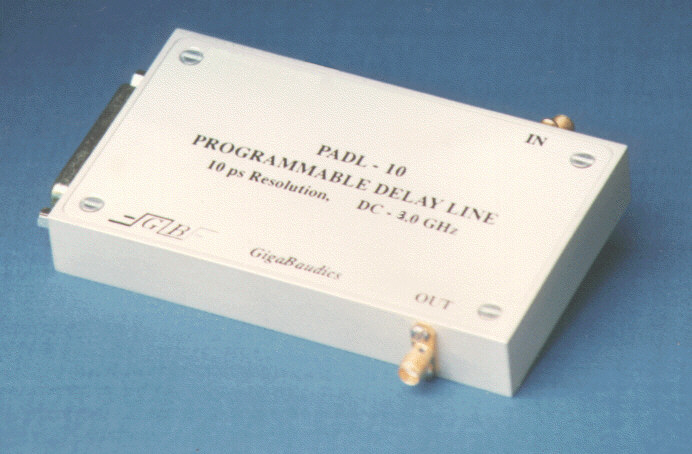
GigaBaudics
4 GHz PROGRAMMABLE DELAY LINE - MODEL PADL
DISCONTINUED - see models PADL3 and PADL6

Features
- High-speed TTL programming
- 50 ohm matched I/O
- DC to 3 GHz bandwidth
- Passive switched-line delays
- 10 Bit (1024 step) range
- Custom step size (5 to 25 ps)
- Time or phase shifting
- Precise repeatability
PRODUCT DESCRIPTION .... SPECIFICATIONS .... PROGRAMMING .... CIRCUIT DIAGRAM .... TRANSFER CHARACTERISTICS .... PRICING AND AVAILABILITY ... HOME PAGE
The PADL is a programmable delay line instrument designed for adjusting the time delay or phase of radio, microwave or even digital signals with bandwidths from DC to 3 GHz. Delays are controlled via a TTL bus.
This instrument is an attractive alternative to either the manually operated, hand-cranked line stretchers which are very time consuming when delays have to be changed frequently and the servo controlled line stretchers which are expensive and wear out quickly. It also has the advantage of lower mismatch, higher bandwidth and higher range than delay lines that use lumped or distributed varactor elements.
Delays are controlled precisely in standard step sizes of 5, 10, 20 or 25 picoseconds or in any custom step size within this range. The delays are 10 bit programmable giving a total of 210=1024 delay steps. Therefore the PADL-5,-10,-20 and-25 have a delay range of 5115, 10230, 20460 and 25575 ps respectively. When this device is used as a programmable narrow-band phase shifter the phase shifts are proportional to the frequency. The equivalent phase shift, per picosecond delay, is 0.36 deg./psGHz or 2.78 ps = 1 deg/GHz.
The PADL3 programmable delay lines employ all GaAs passive microwave switched-line techniques. Lines are switched in a series configuration so that each delay occurs additively with any other switched-in delay. The signal is DC coupled therefore has no lower band limit. Since no active elements are used, input power as high as 20 dBm may be used and still yield less than 1 dB compression.
The PADL3 is calibrated to maintain a high degree of delay accuracy over a wide range of frequencies. The accuracy is better than 1 LSB (20 ps for step sizes above 20 ps). This device has high monotonicity. The accuracy maintained between consecutive delays is 1/2 LSB (1 LSB for 5 ps step sizes). The differential losses between delay elements are balanced so that the total loss does not vary widely between delay states.
Inputs and outputs are connected by SMA jacks while data and control signals are connected by a standard 25 pin D-type subminiature connector plug. Power can be connected either through the D-sub connector or the banana jack. This instrument is provided in low profile rugged aluminum housing and requires a single, low power, 5V power supply making this instrument very easy to use.
The delay lines I/O provide a good match of 50 ohms relative to ground yielding a VSWR of less than 1.3 from DC to 3 GHz and less than 1.5 to 4 GHz. This enhances its usefulness in applications where the signal source and termination are not well matched. Poorly matched I/O terminations can generate reflections that may result in delay-shift aberrations when the incident signal and the reflected signal are coincident.
Fast TTL control logic is used in this instrument for applications requiring rapid delay-state changes. For these high-speed programming applications, option "T" can be used to provide control lines with 110 ohm terminations into the TTL input threshold voltage. This minimizes control signal reflections when delay-state changes exceed 50 MHz.
PADL DIAGRAM

The delay line consists of passive GaAs microwave transfer switches. The switch network series resistance losses are matched with shunt resistance to ground for improved wide-band matching.
TRANSFER CHARACTERISTICS

The diagram above shows the typical transfer characteristics. The differential loss between arbitrary delay states is less than +0.5 dB DC to 2 GHz, +1.0 dB from 2 to 3 GHz and +1.5 dB from 3 to 4 GHz.
Each of the 10 programming bits represents a binary number corresponding to a delay state equal to the binary number times the step size. This gives 210 = 1024 possible combinations and a delay range equal to 1024 x (step size). The control word may be latched by using the "LE" latch line (see function diagram and pin-out diagram). The control word need not be latched if the user wishes to operate the latch transparently. Simply keep the latch line high and the delay state will follow the applied data. Delay-state on/off and off/on time is about 75 ns (with a 9 ns propagation delay).
PIN DIAGRAM

25 pin D-type subminiature connector
POWER REQUIREMENTS
The PADL3 uses a single 5V supply. The current requirement is about 50 mA but may increase up to 200 mA for rapid programming rates. Power dissipation is less than 1 watt. Internal supply voltages are regulated to eliminate supply noise coupling to the signal path. All internal voltages are generated from the single 5V supply, thereby simplifying power-up.
ABSOLUTE MAXIMUM RATINGS
(beyond which damage may occur)
Price: $ 2000 ___Price and specifications subject to change without notice.
Please use E-Mail for any correspondences, either technical or administrative, at address postman@gigabaudics.com
![]() GigaBaudics
5266 Hollister Ave. Ste 221 ●
Goleta, CA 93111 ● (805) 687-5934
GigaBaudics
5266 Hollister Ave. Ste 221 ●
Goleta, CA 93111 ● (805) 687-5934